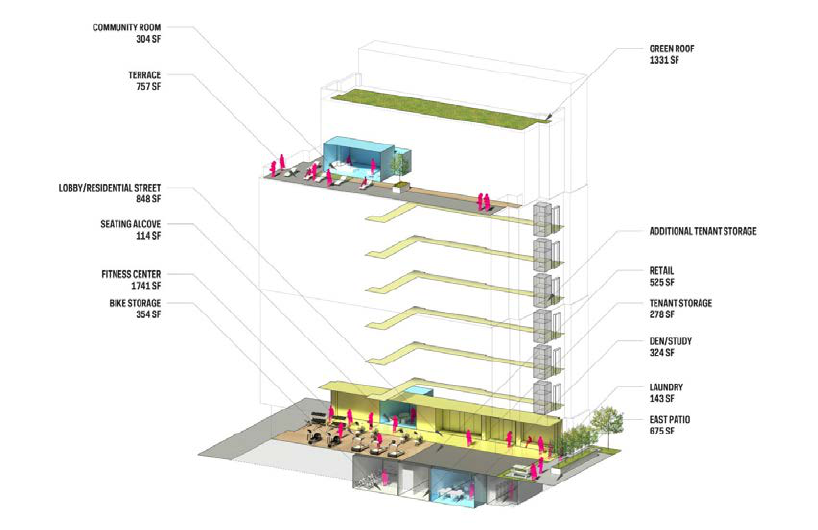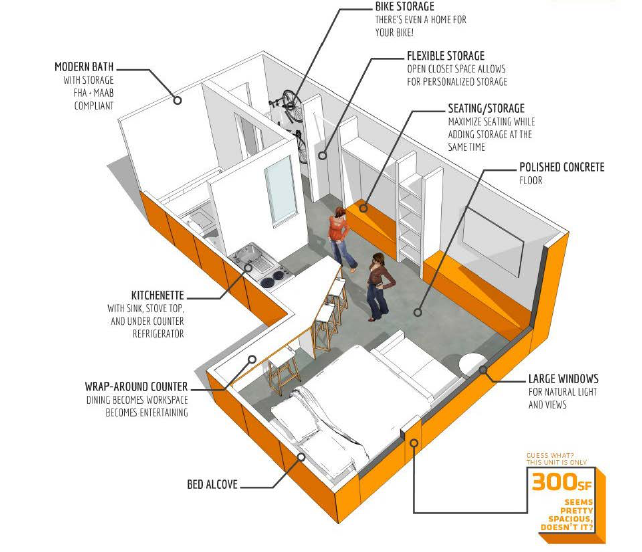
Overview of Impact Fees and Affordable Housing - 1
Overview of Impact Fees and Affordable Housing
The Legislature’s Office of Economic and Demographic Research defines impact fees as a type of
regulatory fee “imposed by local governments against new development to provide for capital facilities’
costs made necessary by population growth. Rather than imposing the costs of these additional capital
facilities upon the general public, the purpose of impact fees is to shift the expense burden to
newcomers.”
1
Examples of capital facilities include the provision of additional water and sewer systems,
schools, libraries, parks and recreation facilities. Impact fees are typically assessed using a fee schedule
that sets forth the charge per type of dwelling unit or per square footage of floor space. These one-
time, up-front charges, are usually paid at the time of building permit approval.
Impact fees have expanded and evolved substantially over recent decades, and currently appear in a
wide variety of forms. In Florida, impact fees are governed through a combination of constitutional and
statutory authority and case law. One way impact fees often intersect with affordable housing is
through the granting of fee waivers or deferrals. These waivers or deferrals essentially represent a local
government’s commitment to subsidize and thereby incentivize the production of affordable housing.
Though common, waivers for affordable housing are not ubiquitous. Like all issues related to impact
fees, decisions to grant waivers for affordable housing are jurisdiction-specific and subject to local
circumstances, vetting (including legal interpretation) and control.
Constitutional and Statutory Authority for Impact Fees
2
The Florida Constitution grants local governments broad home rule powers.
3
Regulatory fees such as
impact fees are home rule revenue sources that may be imposed pursuant to a local government’s
police powers in the exercise of a sovereign function.
4
Impact fees are enacted by local home rule
ordinance and are tailored to meet the infrastructure needs of new growth at the local level. Given their
local creation and emphasis, impact fee calculations vary from jurisdiction to jurisdiction and from fee to
fee. Impact fees also vary extensively depending on local costs, capacity needs, resources, and the local
government’s determination to charge the full cost of the fee’s earmarked purposes.
The Florida Impact Fee Act, s. 163.31801, F.S., provides requirements and procedures to be followed by
a county, municipality, or special district when it adopts an impact fee. These requirements include
basing an impact fee’s calculation on recent and localized data and detailed accounting and reporting of
collections and expenditures.
Case Law and the Dual Rational Nexus Test
Until 2006, the characteristics and limitations of impact fees in Florida were found almost exclusively in
case law rather than state statute. The Office of Economic and Demographic Research’s 2016 Local
Government Financial Information Handbook summarizes the basic parameters of this history.
1
Office of Economic and Demographic Research, 2016 Local Government Financial Information Handbook,
available at http://edr.state.fl.us/Content/local-government/reports/lgfih16.pdf
.
2
Much of the information is this section is derived or summarized from the 2011 Florida Senate Bill Analysis for
SB410 on Impact Fees, available at https://www.flsenate.gov/Session/Bill/2011/410/Analyses/2011s0410.rc.PDF
.
3
FLA. CONST. art VIII, s. 1(f-g).
4
Office of Economic and Demographic Research, 2016 Local Government Financial Information Handbook,
available at http://edr.state.fl.us/Content/local-government/reports/lgfih16.pdf
.

Overview of Impact Fees and Affordable Housing - 2
As developed under case law, an impact fee imposed by a local government should meet the
dual rational nexus test in order to withstand legal challenge. First, a reasonable connection, or
rational nexus, should exist between the anticipated need for additional capital facilities and the
population growth generated by the new development. Second, a rational nexus should exist
between the local government’s expenditure of impact fee proceeds and the benefits accruing
to the new development from those proceeds.
In addition, Florida Impact Fee Act rules require local governments to shoulder the burden of proof
when an impact fee is challenged in court and prohibit the judiciary from giving deference to local
government impact fee determinations.
5
Statewide Impact Fee Revenues
The Florida Department of Financial Services monitors impact fee revenues collected by all local
governments.
6
The most recent data reflect statewide County Impact Fee Revenues of slightly over
$500 million in 2015. Statewide Municipal Impact Fee Revenue Fees were slightly more than $225
million in 2015. Impact revenue fees reached their height in 2006, bottomed out in 2011 and have
increased since then. In 2015, 38 counties reported some type of impact fee collections. There were
193 municipalities reporting collections in 2015.
Selected Year Reporting of County and Municipal Impact Fee Revenues
2006 2011 2015
Counties
$ 1,060,597,975 $ 185,664,703 $ 503,921,835
Municipalities
$ 342,267,200 $ 107,753,843 $ 225,293,910
While the aggregate total of statewide fees has been increasing recently, a 2017 Florida League of Cities
Legislative Issue Brief on Impact Fees states that, “In Florida, average impact fees have been declining
since 2008. In 2008, the average impact fee in Florida for an average single-family detached unit was
$9,832, while in 2015, it was $7,660.”
7
Typical Impact Fee Stakeholders
The U.S. Department of Housing and Urban Development Office of Policy Development and Research’s
(HUD) Impact Fees and Housing Affordability addresses many of the issues related to impact fees as a
local revenue source. The following HUD summary of stakeholder perspectives on impact fees highlights
the differing interests on the subject.
8
5
Chapter 2009-49, L.O.F.
6
Department of Financial Services annual revenue data for each county and municipality from FY 1993 – 2015 is
available at http://edr.state.fl.us/Content/local-government/data/data-a-to-z/g-l.cfm
.
7
Florida League of Cities, 2017 Legislative Issue Briefs: Impact Fees, April 4, 2017, available at
http://www.floridaleagueofcities.com/docs/default-source/Advocacy/Issue-Briefs-Talking-Points/2017-ib---
impact-fees.pdf?sfvrsn=8.
8
U.S. Department of Housing and Urban Development Office of Policy Development and Research’s (HUD) Impact
Fees and Housing Affordability: A Guide for Practitioners, June 2008, available at
file:///U:/USER/JToman/Task%20Force/Impact%20Fees%20-%20HUD%20Guide.pdf
.

Overview of Impact Fees and Affordable Housing - 3
Stakeholder
Perceptions and Concerns
HUD
Need to keep housing affordable, need to help communities
struggling with infrastructure financing problems.
States
Financing of infrastructure is important to economic growth; new
taxes are not popular.
Local Government (planners,
elected officials, active
citizens)
Often want to manage growth, want to preserve housing values,
don’t want new taxes, may have little financial incentive to promote
affordable housing developers.
Developers
Want to maximize return, want a predictable system, cannot always
pass fees on to builder or land owner.
Builders
Want to maximize return, cannot justify building affordable homes if
lot costs and fees are too high.
Home Buyers
Low and moderate-income buyers cannot afford high fees, often
there is no substitute choice of housing.
General Population
Impact fees keep general taxes lower, often do not understand the
impact that fees have on housing prices and the need for affordable
housing.
While the 2008 HUD study analyzes the impact fee issue across the country, it also provides HUD’s take
at the time on the connections among Florida’s varying stakeholders.
Florida, especially, presented a financial “perfect storm.” Population was growing rapidly,
homebuyers were expecting higher levels of services, and the lessening of state and federal
support resulted in ever increasing demands of localities. An increasing share of the
responsibility to pay for these and other public investments fell directly on local jurisdictions by
default. In order to assume control of providing these infrastructure needs, local governments
were forced to pay the associated costs commonly by raising local property taxes. At the same
time, they were hit by the "taxpayers’ revolt." Increasingly, local elected officials faced a public
demand to increase public services without increasing taxes. Impact fees arose from this
environment as an acceptable political alternative to solve the need for financing. Because of
their intrinsic attractiveness to local governments, their use for an ever-increasing number of
facilities and services spread rapidly.
9
Impact Fee Calculations
Given the local authority to adopt impact fees, the considerations and calculations used to set fees vary.
Local governments often commission outside consultant impact studies when contemplating new or
revised fees. These studies inform local government debate surrounding fees and often become the
basis for proposing impact fee ordinances.
Flat or constant fees across houses or apartments provide one of the most basic methods for
establishing residential impact assessments. While relatively easy to calculate and administer, the usage
of fixed amounts is often deemed regressive. HUD has opined that, “Flat rate impact fees compromise
affordability and are socially negative to the degree they systematically overcharge purchasers in
smaller, less expensive houses or apartments and undercharge others in the most valuable houses.”
10
9
Ibid.
10
Ibid.

Overview of Impact Fees and Affordable Housing - 4
Beyond simple flat fees, among the most common residential variables utilized to calculate impact fees
are:
• Dwelling Unit Type (e.g., single-family detached, townhouse, condominium, apartment, etc.)
• Number of Bedrooms, or
• Size in Square Feet.
Designing more Equitable Fees: Proportionate Share
HUD’s Impact Fees and Housing Affordability closely studies the linkage between the cost of new
facilities and corresponding ‘proportionate share’
11
impact fees, especially when it comes to affordable
housing. According to the HUD, “ensuring that impact fees do not charge more than the proportionate
share is fair and equitable and protects affordable housing from paying a disproportionate share.” While
fee-to-cost calculations based on dwelling unit type and number of bedrooms are examined, the authors
believe that “the simplest and most universal factor associated with actual costs is the square footage of
the home.”
For certain impact fees, particularly those covering libraries, parks, open space and construction
of schools, square footage of the homes may be sufficient for allocating costs. For other fees,
such as those covering roads, public safety and water or drainage, additional significant
variables should also be considered along with dwelling unit square footage in determining the
appropriate costs and payments. Depending on the particular fee, these variables might include
size of lots and the density of subdivisions or broader neighborhoods. But the key point is that
basing all types of impact fees in whole or in part on house or apartment square footage rather
than charging uniform rates is straightforward to implement and helps to avoid overcharging
smaller units more than their true proportionate share.
12
The National Association of Home Builders’ Proportionate-Share Impact Fees Supplement answers the
HUD position by stating that “Rough proportionality can be satisfied with the calculation of one impact
fee for all residential units.”
13
Local jurisdictions that develop more complicated methods in an attempt to calculate
proportionate-share impact fees will find the resulting fee schedules more difficult to defend,
more costly to calculate, and more time consuming to administer.
14
Modifying or Waving Impact Fee Requirements for Affordable Housing
No matter what methodology is used to calculate and set impact fees, implicit is the notion that they
apply to all groups, categories of construction or activities that create a demand for the facilities or
services designated. To lessen the brunt of impact fees on affordable housing developments, many local
11
In Dolan v. Tigard (512 U.S. 687 (1994)) the US Supreme Court established the “rough proportionality” standard
for exactions such as impact fees. The court ruled that “the necessary connection required by the Fifth
Amendment is ‘rough proportionality.’ No precise mathematical calculation is required but the (local government)
must make some sort of determination that the required (exaction) is related both in nature and extent to the
proposed development's impact.
12
HUD, 2008.
13
Malizia and Gallo, Proportionate-Share Impact Fees: Supplement to the NAHB Impact Fee Handbook, 2008
Version, available at
file:///U:/USER/JToman/Task%20Force/Imapct%20Fees%20-
%20NAHB%20Proportionate%20Share%20Dicsussion.pdf.
14
Ibid.

Overview of Impact Fees and Affordable Housing - 5
governments in Florida pursue alternative methods of fee payment for affordable housing. While often
characterized as ‘waivers,’ the fees are ultimately subsidized from another revenue source.
An Indian River County Affordable Housing Advisory Committee Incentives Review and Recommendation
Report summarizes this position on the impact fee waiver/modification issue.
Legally, impact fees must be applied to all activities that create a demand for capital facilities.
Consequently, impact fees cannot be waived or reduced. There are, however, alternative
methods of fee payment to assist income eligible persons with the cost of impact fees and /or
utility capacity charges.
15
The report’s analysis continues on to explain the economic rationale girding any waivers of impact fees.
Waiving impact fees does not eliminate the cost of the infrastructure that the impact fees
are designed to pay for. Either new development or existing residents must pay the cost
of needed infrastructure improvements. If new development, which puts additional
demand on county facilities, does not pay its fair share of infrastructure cost through
impact fees, then existing residents will have to pay those costs through higher fees or
taxes.
16
Indian River County’s ‘alternative methods’ of payment include impact fee loans and grants to low
income households through the SHIP program and as part of CDBG neighborhood revitalization and
housing projects.
17
Though many local governments assert the necessity of replacing surrendered impact fees, there is no
direct statutory provision prohibiting waivers. Because impact fee authority (and the associated ability
to waive fees) is derived from home rule powers, case law remains an important current and ongoing
influence. The Florida League of Cities 2017 Issue Brief on Impact Fees encapsulates the issue this way:
Impact fees and transportation concurrency are adopted by ordinance, which is a legislative
decision of the city’s governing body. Current law authorizes municipalities to waive the
collection of impact fees. As a result, some cities have made the local decision to waive them,
hoping this will be a catalyst for economic development and foster growth. Other cities have
examined their current infrastructure needs and concluded imposing impact fees or
transportation concurrency is necessary to adequately fund the development or growth.
18
Canvassing SHIP Administrators on Local Government Impact Fees
Florida Housing staff recently queried SHIP Administrators regarding impact fee calculations and waivers
in their locales. Responses from the 80+ reporting local governments (out of 119) vary widely. The
15
Indian River County Affordable Housing Advisory Committee, 2008 Incentives Review and Recommendation
Report, available at http://www.ircgov.com/Boards/AHAC/AHAC2008report.pdf
.
16
Ibid.
17
Ibid.
18
Florida League of Cities, 2017 Legislative Issue Briefs: Impact Fees, April 4, 2017, available at
http://www.floridaleagueofcities.com/docs/default-source/Advocacy/Issue-Briefs-Talking-Points/2017-ib---
impact-fees.pdf?sfvrsn=8.
Overview of Impact Fees and Affordable Housing - 6
range of methodologies utilized to set fees, combined with the assorted wavier policies linked to
affordable housing, reflect the disparate nature of impact fees across the state.
Approximately 25 percent of the responding cities and counties do not currently levy any impact fees.
For those which do levy impact fees, calculations based on unit type are common. These unit type
calculations were cited by approximately 60 percent of respondents levying fees. Very often, the unit
type calculation is then further delineated by square footage metrics (about 33 percent referenced
usage of square footage, either exclusively or in combination), numbers of bedrooms, geographic
locations within the city or county, or resident status as a senior citizen. Flat fee rates were cited by just
under 30 percent of the respondents. Finally, nearly 30 percent of the reporting local governments
provide mechanisms to waive fees in part or whole for affordable housing.
Below are representative samplings of replies received.
• Hillsborough County Assess residential impact fees using a mixture of methods including
location in the County (the zone). Mobility is Type and Size; Parks is Type and Bedroom count;
School is Size; and Fire is a Flat rate. Affordable Housing has a program to provide
relief. Multifamily developments are provided 90% relief for Park, Fire and Mobility
fees. Single family construction is provided 100% relief for all but School Impact fees.
Hillsborough County can also lower the Mobility Fee for houses less than 1500 square feet of
living area if Affordable Housing provides documentation that shows the annual household
income meets select SHIP definitions (less than 50%, and between 50-80%)
• Manatee County Now utilize square footage for impact fees. Board just approved an
innovative new program called Livable Manatee. Local government will pay, from a County
source, the County Impact Fees, School Impact Fees and Facility Investment Fees for new
construction affordable units for both homeownership and rental up to a maximum of
$500,000 per development (have resolution putting this into effect). The fund is a limited fund
that once depleted may or may not be re-established. Local government is legislatively looking
into the possibility of fee waivers for affordable housing units that would help us to continue
this program effectively.
• Marion County Residential Impact fees based on size. Only adopted and collect 10% of what
the impact study said the cost of a residential unit is ($10,000 in capacity cost per unit, we
collect $1000).
• City of Palm Bay City annually adopts Fair Share Impact Fees by Resolution. The fees are a
combination of flat fee and calculated additional fees based upon square footage. No waiver
or reduction is permitted; however, the Growth Management Director retains authority to
structure a payment plan.
• City of St. Petersburg Approved an Ordinance on July 13, 2017 that establishes a flat fee of
$250.00 for single-family residential properties that are less than 1400 SF in size. By
comparison, the fee scheduled that was revised, a new 1200 sf home that had a construction
value of $100,000 would have been charged $787.50 in permit fees
• City of Cape Coral Impact fees by type of development/construction: 1) residential – single
family duplex; 2) commercial – multi-family over 3 units and non-residential uses. In the
process of implementing a pilot impact fee program for affordable housing. Single family
impact fees levied by the City would be deferred until the first sale of the property. This
program will be limited to non-profit housing developers. Multi-Family impact fees will be
bought down over a period using a Synthetic Tax Increment Financing model.
Overview of Impact Fees and Affordable Housing - 7
• Charlotte County Flat rate impact fee levy by type of property being built. In the process
of developing a request for a reduction or waiving of all fees for affordable housing. Board of
County Commissioners consensus that the County’s current impact fees are 40% of what they
should be.
• Flagler County Impact Fees for transportation, parks and recreation, and educational facilities,
with the transportation impact fee presently in a moratorium. These fees are collected for
development within unincorporated Flagler County and for development within the City of
Bunnell through interlocal agreement. The fees are based on type of land use and vary based
on the type of unit being developed: single-family residential, multifamily residential, or
mobile home residential. Currently an exemption from educational facilities impact fee for
low-income housing. In the past, the County has sporadically waived impact fees by paying
them from County funds. Such waiver/payment by the County is subject to Board of County
Commissioner review and approval.
• City of Largo Charges impact fees (sewer and water, mobility and parkland/recreation) based
on Type of Residence. A housing development that requests approval to be deemed an
"Affordable Housing Development" may receive assistance with the impact fees from our SHIP
program for the affordable set-aside units.
• Miami-Dade County Impact fees by type of use and region in the County. Impact fees are
required to be paid prior to the issuance of any building permit for development activity within
Miami-Dade County. No building permit may be issued until all required impact fees are paid
in full. Miami-Dade County collects impact fees for Road, Fire and Emergency Services, Police
Services, Parks and Educational Facilities. The application is reviewed for size (a square
footage maximum) and type of land use for the new development. Ordinances exempt from
the required payment of impact fee housing units which provide affordable housing for low
and very low-income families.
• Orange County Impact Fees are levied and assessed by type of residence (single-family vs
multi-family). For affordable housing projects, impact fees are not reduced or waived, but may
be deferred until construction is complete.
• Seminole County Impact fees based on unit type and region of County. The largest single
impact fee is the school impact fee. Seminole County has been examining ways to provide a
modification of impact fee requirements including but not limited to reduction, waiver or
alternative methods of payment of impact fees. To date, a funding source as not been
identified to provide an alternative payment of impact fees. The funding source, policy and
procedures to implement such a program has not been located and implemented.
• Santa Rosa No current impact fees. Impact fees were first collected by Santa Rosa County
1/1/2006 and were suspended indefinitely as of 12/31/2009. When collected, based
residence type and location in rural or urban areas. Would be collected in either one lump sum
amount or payments over a 7-year tax period.
• City of Fort Meyers Impact fees for residential structures are assessed at a flat per unit rate
based on the unit type (SF, MF/SFA/Duplex, Mobile Home) while the impact fees for
commercial structures are based on square footage and type of use. Currently there are no
waivers or reductions in place.
• City of Port St. Lucie Tiered impact fees based on square footage for unit. Reduction of impact
fees for in-fill housing or housing in different areas of the city, such as CRA, etc.
• Palm Beach County By flat rate, type of residence and size of unit. Palm Beach County’s
impact fee program is comprised of 7 impact fee components. The road, law enforcement and
Overview of Impact Fees and Affordable Housing - 8
fire rescue impact fees are flat rates depending upon whether single family or multi-
family. The remaining impact fee components are contingent upon the square foot size of the
proposed construction. Palm Beach County does not waive impact fees. However, the BCC
has approved an affordable housing assistance program that may assist with the payment of
road, public building and park impact fees. Assistance is dependent upon funding availability
and approval of the Board of County Commissioners.
• City of Ocala Impact fees (water, sewer) for homes are assessed based on the square footage
under air/heated space. Apartments/condos are assessed based on the number of bedrooms
they have. There is no concession for affordable housing projects within impact fee ordinance
(70-502), but there is an Affordable Housing Fund that can offset the development fees.

IMPACT FEE INFORMATION FROM SHIP ADMINISTRATORS
T = By Type of Unit
S = By Square Footage
F = Flat Fee
W = Waivers/Reductions/Deferrals
1
City of
Coconut
Creek
To implement an affordable housing program, an affordable housing
linkage fee is paid at the time of the issuance of building permits for all
non-residential development.
Industrial $0.37 per square foot
Commercial $1.36 per square foot
Office $0.15 per square foot
Hotel $2.42 per square foot
Limited service hotel $0.70 per square foot
As an alternative to payment of the housing linkage fee, a developer of
non-residential project or mixed-use project may submit a request to
produce affordable housing units, which request can be granted in the
form of a developer's agreement approved by the city commission.
Alachua
County
S
Base the impact fee on unit size. Do not have anything in place to
reduce the cost or waive the impact fee.
City of
Boynton
Beach
T
S
F
W
Impact Fees are levied at flat rates according to:
• Type and size of residence
• Number of bedrooms
Certain waivers may be considered depending upon if there was ever a
dwelling at the site in the past; permitting process is expedited if project
is certified affordable.
City of
Bradenton
T
S
Imposes impact fees by square footage, number of fixtures, or type of
unit depending on what the fee is for.
City of
Deltona
T
S
By type of residence (single family or multifamily) and by square
footage. No waivers.
City of Fort
Lauderdale
S
F
Parks Impact Fee (by dwelling unit size unit; flat fee for hotel/motel
rooms).
Hillsborough
County
T
S
W
Assess residential using a mixture of methods including location in the
County (the zone). Mobility is Type and Size; Parks is Type and Bedroom
count; School is Size; and Fire is a Flat rate. Affordable Housing has a
program to provide relief. Multifamily developments are provided 90%
relief for Park, Fire and Mobility fees. Single family construction is
provided 100% relief for all but School Impact fees. Hillsborough
County can also lower the Mobility Fee for houses less than 1500 square
feet of living area if Affordable Housing provides documentation that
shows the Annual HH Income meets select SHIP definitions (less than
50%, and between 50-80%)
City of
Hollywood
s
“Park Impact Fee” assessed on square footage basis for single family or
multi-family residential units and on a per room basis for hotel/motel

IMPACT FEE INFORMATION FROM SHIP ADMINISTRATORS
T = By Type of Unit
S = By Square Footage
F = Flat Fee
W = Waivers/Reductions/Deferrals
2
units. Other impact fees are assessed by Broward County. No waivers,
however, affordable housing projects are given a priority in the
permitting process.
Indian River
County
T
S
Charges impact fees per unit by type of the unit (single family, multi
family, mobile homes). To lessen the burden on smaller affordable
housing single family units IRC has three categories for single family
impact fees based on the size of the unit (less the 1500 Sq. Ft., between
1500- 2499 Sq. Ft., or 2500 Sq. Ft. and larger).
Because impact fees are based on fair share payments by the people
benefiting from the capital improvements, impact fees and utility
capacity charges cannot be waived or reduced for any individual group
or category of construction. On the other hand, those fees increase the
cost of housing and put a burden on the production of affordable
housing projects. To lessen the impact of those fees on affordable
housing projects, the cost of impact fees may be paid by other funding
sources. IRC pays impact fees for VLI, LI, and MI households with SHIP
funds (i.e. Habitat for Humanity (HFH) clients for building their new
single family units always apply for and
Manatee
S
Now utilize square footage. Board just approved an innovative new
program called Livable Manatee. LG will pay, from a County source, the
County Impact Fees, School Impact Fees and Facility Investment Fees for
new construction affordable units for both homeownership and rental
up to a maximum of $500,000 per development (have resolution
putting this into effect). The fund is a limited fund that once depleted
may or may not be re-established. LG is legislatively looking into the
possibility of fee waivers for affordable housing units that would help us
to continue this program effectively.
Marion
County
S
Residential Impact fees based on size. Only adopted and collect 10% of
what the impact study said the cost of a residential unit is ($10,000 in
capacity cost per unit, we collect $1000).
Martin
County
S
W
Impact fees are assessed by size of unit and Martin County allows to
defer impact fees for affordable housing.
City of
Ocala
S
Impact fees (water, sewer) for homes are assessed based on the square
footage under air/heated space. Apartments/condos are assessed
based on the number of bedrooms they have. There is no concession
for affordable housing projects within impact fee ordinance (70-502),
but there is an Affordable Housing Fund that can offset the
development fees.
City of Palm
Bay
S
F
The City annually adopts Fair Share Impact Fees by Resolution. The fees
are a combination of flat fee and calculated additional fees based upon
square footage. No waiver or reduction is permitted; however, the

IMPACT FEE INFORMATION FROM SHIP ADMINISTRATORS
T = By Type of Unit
S = By Square Footage
F = Flat Fee
W = Waivers/Reductions/Deferrals
3
Growth Management Director retains authority to structure a payment
plan.
Palm Beach
County
T
S
F
By flat rate, type of residence and size of unit. Palm Beach County’s
impact fee program is comprised of 7 impact fee components. The
road, law enforcement and fire rescue impact fees are flat rates
depending upon whether single family or multi-family. The remaining
impact fee components are contingent upon the square foot size of the
proposed construction. Palm Beach County does not waive impact
fees. However, the BCC has approved an affordable housing assistance
program that may assist with the payment of road, public building and
park impact fees. Assistance is dependent upon funding availability and
approval of the Board of County Commissioners.
Pinellas
County
T
S
Impact fees are levied based on the type of residence and the size of the
unit. Do not reduce or waive impact fees but County has the ability to
waive review fees associated with the development.
City of Port
St. Lucie
S
Tiered impact fees based on square footage for unit. Reduction of
impact fees for in-fill housing or housing in different areas of the city,
such as CRA, etc.
St. John’s
County
S
By size of unit (>1,800 sq. ft.; <1,800 sq. ft.). There is an ordinance that
allows for the expedited review of affordable housing
developments. However, it has not been utilized in many years.
City of St.
Petersburg
S
F
Approved an Ordinance on July 13, 2017 that establishes a flat fee of
$250.00 for single-family residential properties that are less than 1400
SF in size. By comparison, the fee scheduled that was revised, a new
1200 sf home that had a construction value of $100,000 would have
been charged $787.50 in permit fees.
City of
Tampa
S
School Impact Fee is based on square footage (these apply only to
projects with residential occupancies). For utilities, some are based on
meter size, but there are also charges based on area and special
considerations that may be unique to a given project. Do have
multimodal fee exemption areas (Ybor and East Tampa). Do not exempt
for affordable housing, per se, but Ybor and East Tampa are considered
blighted. Multimodal fees have not changed since 1989.
Bay County
T
F
Bay County charges a flat fee for residential based on the type of
dwelling unit. Impact fee reduction is a strategy used to produce
affordable housing.
Broward
County
T
W
School impact fees are assessed based on the type of dwelling units and
the number of bedroom for each type of unit. Transportation
concurrency impact fees are assessed based on the number of PM peak
hour trips generated by the number of dwelling units and type of units.

IMPACT FEE INFORMATION FROM SHIP ADMINISTRATORS
T = By Type of Unit
S = By Square Footage
F = Flat Fee
W = Waivers/Reductions/Deferrals
4
Per the Land Development Code Sec. 5-182(a)(5)3), applications for
building permits for "very low income" and "low income" affordable
housing projects, as defined in Division 6 of this article, shall be eligible
for a waiver of one hundred percent (100%) of the Transportation
Concurrency Assessment.
City of Cape
Coral
T
W
By type of development/construction: 1) residential – single family
duplex; 2) commercial – multi-family over 3 units and non-residential
uses. In the process of implementing a pilot impact fee program for
affordable housing. Single family impact fees levied by the City would be
deferred until the first sale of the property. This program will be limited
to non-profit housing developers. Multi-Family impact fees will be
bought down over a period using a Synthetic Tax Increment Financing
model.
Charlotte
County
T
F
Flat rate levy by type of property being built. In the process
of developing a request for a reduction or waiving of all fees for
affordable housing. This is not being embraced by the Board of County
Commissioners because their consensus is that the County’s impact fees
are 40% of what they should be.
Clay County
T
F
W
Currently, School Impact Fees are in place. Transportation Impact Fees
are scheduled to begin January 1, 2018. School Impact fees are a flat
rate of $7,034.00 for a S/F residence, $5,900 for a mobile home and
$3,200 per unit for apartments. Affordable Housing and Workforce
Housing Impact Fees are eligible for deferral by filling out the
Application for Deferral.
I would be happy to send you a copy of the ordinance that discusses the
deferral of impact fees.
Flagler
County
T
W
Impact Fees for transportation, parks and recreation, and educational
facilities, with the transportation impact fee presently in a
moratorium. These fees are collected for development within
unincorporated Flagler County and for development within the City of
Bunnell through interlocal agreement. The fees are based on type of
land use and vary based on the type of unit being developed: single-
family residential, multifamily residential, or mobile home residential.
Currently an exemption from educational facilities impact fee for low-
income housing. In the past, the County has sporadically waived impact
fees by paying them from County funds. Such waiver/payment by the
County is subject to Board of County Commissioner review and
approval.
City of Fort
Meyers
T
S
F
The impact fees for residential structures are assessed at a flat per unit
rate based on the unit type (SF, MF/SFA/Duplex, Mobile Home) while

IMPACT FEE INFORMATION FROM SHIP ADMINISTRATORS
T = By Type of Unit
S = By Square Footage
F = Flat Fee
W = Waivers/Reductions/Deferrals
5
the impact fees for commercial structures are based on square footage
and type of use. Currently there are no waivers or reductions in place.
City of Fort
Pierce
T
Impact fees are assessed by type of residence primarily, with the
variable of size of unit if a Single-family home. No reduction, waiver or
change in process for affordable housing projects, however density and
other development incentives exist for affordable housing projects.
Hernando
County
T
Assessed by type of residence
City of
Kissimmee
T
Assessed by type of residence.
City of
Lakeland
T
W
By type of residence. City’s Affordable Housing Incentive Plan provides
for waiver of impact fees, in full or in part, for qualified affordable
housing projects.
Lake County
T
W
Flat fee that covers road, school, fire, parks, and library. County will not
waive impact fees for developments unless the development is located
near a school, and then the School Board has to vote on whether or not
to grant that waiver. The County typically won’t waive impact fees
though. The city that the development is located in might, and has on
many occasions if the development adds to the economic value of the
area that its developing in.
City of
Largo
T
W
Charges impact fees (sewer and water, mobility and
parkland/recreation) based on Type of Residence. A housing
development that requests approval to be deemed an "Affordable
Housing Development" may receive assistance with the impact fees
from our SHIP program for the affordable set-aside units.
Lee County
T
W
Assessed by type of unit. The Lee County Board of County
Commissioners and the School District have established a program that
reimburses up to half (50%) of the amount paid for school impact fees
for new construction of single-family or multi-family homes to be
occupied by income eligible households.
Margate
T
F
Police and Fire & EMS (flat fees for residential, per 1000 SF for
nonresidential) Water Connection and Waste Water Surcharge (by unit
type). Do not have any policy in place for fee reductions, waivers or
process for affordable housing.
City of
Miami
T
Levies by type of residence. There is a deferral of impact fees for
affordable housing with a covenant that it remains affordable housing in
perpetuity. The impact fees are paid at the prevailing rate if the
property is no longer an affordable housing property.
City of
Miami
Beach
T
The concurrency fee for affordable housing is based on the number of
units proposed. As far as parking, it is 0.5 parking space per dwelling
unit for elderly housing or 1.00 parking space per dwelling unit of 800
square feet or less for non-elderly low and/or moderate-income
housing. Elderly person shall be defined as a person who is at least 62
years of age. Non-elderly person is a person who is of legal age but less

IMPACT FEE INFORMATION FROM SHIP ADMINISTRATORS
T = By Type of Unit
S = By Square Footage
F = Flat Fee
W = Waivers/Reductions/Deferrals
6
than 62 years of age. Elderly household means a one- or two-person
household in which the head of the household or spouse is at least 62
years of age. Non-elderly household means a one- or two-person
household in which the head of the household or spouse is of legal age
but less than 62 years of age. At the moment, staff is amending certain
parking requirements for affordable housing.
Miami-
Dade
County
T
W
By type of use and region in the County. Impact fees are required to be
paid prior to the issuance of any building permit for development
activity within Miami-Dade County. No building permit may be issued
until all required impact fees are paid in full.
Miami-Dade County collects impact fees for Road, Fire and Emergency
Services, Police Services, Parks and Educational Facilities. The
application is reviewed for size (a square footage maximum) and type of
land use for the new development. Ordinances exempt from the
required payment of impact fee housing units which provide affordable
housing for low and very low-income families.
City of
Miramar
T
F
Flat rate fees: Police & Fire is per dwelling unit; Parks & Recreation are
calculated per bedroom; Water & Sewer is a flat rate too.
Nassau
County
T
Working on revising affordable housing incentives through the needs
assessment process but for now these are usually incorporated into
PUDs/Developer agreements as bonuses to allow for an increase in
density for the provision of affordable housing units. It's possible the
County will have additional measures/approaches next year.
Okaloosa
County
Okaloosa County Water & Sewer refers to impact fees as Capacity
Expansion Charges (CECs). There are unit prices for CECs that are based
on Equivalent Residential Units (ERU). An ERU is considered to be the
equivalent of one single family residence. Most single family residential
construction units are charged for one ERU for sewer and one ERU for
water, depending on sewer and/or water being available to the
property. For apartments and condos, each unit would be charged on
ERU. A 20-unit apartment project would be charged for 20 ERUs with
possible additional ERUs for pools, public bathroom, etc. There are
various methodologies for determining how many ERUs to charge for
non-residential projects. The most common is the number of gallons per
day of potential demand. One ERU is calculated as either 300 gallons
per day per ERU or in some cases 350 gallons per day per ERU. ERUs on
non-residential projects can also be based on formulas which use
square footage, or in the case of restaurants, numbers of tables, etc.
No provision for reduction, waiver or change in process for any reason.
This is a requirement in the County’s bond covenants.

IMPACT FEE INFORMATION FROM SHIP ADMINISTRATORS
T = By Type of Unit
S = By Square Footage
F = Flat Fee
W = Waivers/Reductions/Deferrals
7
Orange
County
T
Impact Fees are levied and assessed by type of residence (single-family
vs multi-family). For affordable housing projects, impact fees are not
reduced or waived, but may be deferred until construction is complete.
City of
Orlando
T
W
Levies Transportation, Parks and Sewer Impact fees based on the type
of residence. A discount is applied to affordable housing projects for
Transportation and Parks impact fees. Sewer Impact fees can be
reimbursed for affordable housing if SHIP funds are available.
City of
Panama
City
Panama City uses the number of new water and sewer fixtures per unit
as the triggers for determining impact fees. No longer offers impact fee
reductions as a strategy to produce affordable housing.
City of
Pembroke
Pines
T
Impact fees (fire, police) are assessed by type of residence.
Pinellas
County
T
Multi-modal impact fee by residence type.
City of
Plantation
T
By residence type. No reductions for affordable housing.
Polk County
T
W
Provides full waiver of impact fees for affordable housing
developments, single and multi-family for households making less than
80% of area median income. The County also provides mitigation of 50%
of impact fee costs for workforce housing developments, single family
and multi-family for households making up to 120% of area median
income for the Lakeland – Winter Haven MSA.
City of
Pompano
Beach
T
F
Charges impact fees for parks (community and neighborhood parks).
These park impact fees are determined based on the location in the city,
the type of residential structure (i.e. single family, townhomes, garden
apartment, etc.), and number of bedrooms. Do not give waivers for
affordable housing at this time.
St. Lucie
County
T
F
Both flat rate and by the type of residence. One for a single-family
home, one for multi-family, etc. and not based on size. The fire impact
fee is different for multi-family if it is more than 3 floors in height. No
waivers for affordable housing.
Seminole
County
T
Impact fees based on unit type and region of County. The largest single
impact fee is the school impact fee. Seminole County has been
examining ways to provide a modification of impact fee requirements
including but not limited to reduction, waiver or alternative methods of
payment of impact fees. To date, a funding source as not been
identified to provide an alternative payment of impact fees. The
funding source, policy and procedures to implement such a program has
not been located and implemented.
City of
Titusville
T
Impact fees based upon type of use and number of units. There is a
deferment in place for affordable housing projects.

IMPACT FEE INFORMATION FROM SHIP ADMINISTRATORS
T = By Type of Unit
S = By Square Footage
F = Flat Fee
W = Waivers/Reductions/Deferrals
8
Volusia
County
T
Residential impact fees are levied by type of residence: Single Family,
Apartment, Residential Condominium/Townhouse Complex, Mobile
Home within a Park. There is not reduction, waiver or change in process
for affordable housing.
Citrus
County
W
Promote the development of affordable single family residential homes
by charging transportation impact fees at a reduced level and deferring
impact fees for 10 years for qualified affordable housing. The impact
fees will be permanently cancelled after 10 years unless the home is
sold.
Qualified Affordable Housing - Homes with less than 1,500 square feet
of living area (site built, mobile home, modular, etc.) and occupant
households being at or below low income (80% of area median income,
adjusted for family size as defined by the U.S. Department of Housing
and Urban Development (HUD)
Only lower income owner occupants and Not-for-Profit Single Family
Residential Housing Developers working with eligible clients will be
eligible for the Affordable Housing Land Use Category and Deferral of
Impact Fees.
This must be the homestead property of the owner occupant. Owners
that own or intend to own investment property are not eligible. Homes
built for “speculation” by builders or developers are not eligible.
City of
Daytona
Beach
W
Discounts its permit filing fees by 50% for affordable housing projects.
Additionally, permits for affordable housing projects are expedited to a
greater degree than other projects. The City also donate real property
from its inventory for use in producing permanent affordable housing.
City of
Tamarac
Currently use a negotiated development agreement for impact fees. In
the process of doing a fee study and will most likely change that model
pending the recommendations from the study.
City of
Deerfield
Beach
Police, Fire and Parks impact fees. The City is located in Broward County
which allows any municipality to assess fees for affordable housing in a
land use or rezoning change if, more than 100 units are proposed and if
a study determines that affordable housing is needed. To date, the City
has not exercised this option.
City of
Hialeah
F
Any new construction or addition that it is done in the City has to go to
Miami Dade County and they assess an impact fee. The City of Hialeah
only charges a Parks Impact Fee and Fire Impact Fee for multi-family
projects and it’s a flat rate.
Jackson
County
F
Flat rate impact fees for single family residences in the amount of
$500.00 each for water and sewer.

IMPACT FEE INFORMATION FROM SHIP ADMINISTRATORS
T = By Type of Unit
S = By Square Footage
F = Flat Fee
W = Waivers/Reductions/Deferrals
9
Monroe
County
F
W
County collects a flat fee on new market rate residential dwelling units.
Replacement market rate residential dwelling units are not charged
impact fees regardless of the size of the unit (larger or smaller).
Deed restricted affordable housing dwelling units are not charged any
impact fees.
Walton
County
F
Building department collects $25 fire impact fees per house at building
permit. City of DeFuniak does not waive water and sewer tap and
impact fees but contributes to the project on the amount of the fees.
Calhoun
County
None
Columbia
County
None
De Soto
County
None
Dixie
County
None
Duval
County
None
Escambia
County
None
Franklin
County
None
City of
Gainesville
None. The City does require the payment of Connection Fees for water
and wastewater. In some ways, Connection Fees are similar to Impact
Fees (for example, Connection Fees are used for long term maintenance
and infrastructure). Connection Fees are assessed by type of residence
and there is no reduction, waiver or change in process for affordable
housing projects.
Gilchrist
County
None
Hamilton
County
None
Hendry
County
None
Highlands
County
T
S
F
W
Currently, a moratorium in place on impact fees. When the County
decides to implement impact fees again, a new study for all impact fee
categories will need to occur and categories and rates will be decided
with that study. Historically, residential impact fees where based on the
following categories.
1. Single-Family (less than 1,500 sq. ft., 1,501-2,408 sq. ft., greater
than 2,500 sq. ft.). A flat rate will be evaluated in future studies.
2. Multi-Family (Flat Rate)
3. Mobile Home (Flat Rate)

IMPACT FEE INFORMATION FROM SHIP ADMINISTRATORS
T = By Type of Unit
S = By Square Footage
F = Flat Fee
W = Waivers/Reductions/Deferrals
10
4. Retirement/Age-Restricted Single-Family (Flat Rate)
Affordable Housing was exempt from impact fees as long as it met the
criteria of Affordable Housing outlined in the Impact Fee Ordinance.
Lafayette
County
None
Leon
County
None (eliminated its transportation impact fee in 1995).
Madison
County
None
City of
Pensacola
None
Santa Rosa
None. Impact fees were first collected by Santa Rosa County 1/1/2006
and were suspended indefinitely as of 12/31/2009. When collected:
SFR = $2,090 for Urban areas and $1,222 for Rural areas; Multi-Family =
$1,468 Urban and $858 for Rural (per unit). Would be collected in
either one lump sum amount or payments over a 7-year tax period.
Suwannee
County
None
Union
County
None
FHFC October 2017

Overview of Micro-Units – 1
Overview of Micro-Units
At the September 27, 2017, Affordable Housing Workgroup meeting, local planners from Orange County
presented a preliminary housing concept to build micro-units as an affordable housing option in their
Transit-Oriented Development District. Some policy makers have inquired whether micro-unit
developments could be an attractive and less expensive option, particularly in denser urban areas, for
lower income, single-person households. This overview explores micro-unit development in the United
States to provide more insight on the description, design, development and operation of micro-units in
the current rental housing market.
What is a Micro-Unit?
The concept of micro-units does not have a standard definition in today’s housing market. They
typically vary in size and are often guided by the minimum dwelling size requirements and
trends of the market in which they exist. For example, the minimum size requirement for an
apartment in Washington, D.C. is 220 square feet compared to North Miami, FL, regulations
that limit a dwelling to a size of no less than 750 square feet. The cultural trends of an area can
also influence what is considered as a micro-unit. Conventional apartments in South Florida are
typically larger in size than apartments New York City. Therefore, scaling down in apartment
size would be viewed and implemented differently in both cities. A broad interpretation of a
micro-unit is an apartment that is smaller than the average studio and is intended for a single
resident. In 2014, the Urban Land Institute (ULI) conducted a detailed study and market analysis
of micro-units in United States. The ULI study indicates that micro-units can be described as a
small studio apartment, less than 350 square feet with a functional kitchen and bathroom that
meets federal Fair Housing Act design and construction requirements.
Figure 1: Example of a Micro-Unit Floorplan – Curbed NY, What is a Micro Home
Micro-Unit Tenant Demographics and Location
The ULI research revealed that micro-units are typically designed and targeted for young single
professionals. Males under the age of 30 more often rent this type of unit than other
demographic groups. Micro-units appeal more to young single professionals because they are
often first-time renters who have minimal items, such as furniture. Typically, micro-unit tenants

Overview of Micro-Units – 2
live in their units for one or two years, and then leave to reside in a larger and more
conventional apartment (ULI, 2014). This trend can be due to a change in family structure, an
increase in accumulated things and a general cultural desire for more space. Social trends and
demographic and economic changes are increasing the level of interest in micro-units, such as:
• Delayed household formation;
• An increase in one-person households;
• Living in the city and closer to work is becoming more desirable; and
• Younger households have less accumulated stuff.
In the United States (U.S.), micro-units are frequently built in dense urban downtown regions
close to major employment centers and trendy neighborhoods. Research reveals that micro-
unit tenants typically have a low need or desire to socialize inside their units (ULI, 2014).
Therefore, access to external residential community and neighborhood amenities is very
important for these residents. To meet these needs and properly incentivize the trade-off of
smaller spaces, micro-unit developers in the U.S. may offer residential amenities such as large
landscaped outdoor spaces, fitness centers, grilling areas, pet grooming stations, laundry
facilities and community social spaces. By offering a wide range of amenities, residents are
more likely to accept much smaller spaces due to the variety and ease of access to amenities
available to them directly outside of their residence (ULI, 2014).
Figure 2: Example of Amenities in a Micro-Unit Development – Carmel Place, NYC, NY

Overview of Micro-Units – 3
Motivations to Rent Micro-Units
The key factors that motivate people to rent micro-units are their location within a city, their
proximity to walkable neighborhoods and the amenities offered inside the unit and residential
development (ULI, 2014). Price is not always a primary factor but is often a high motivation for
renting.
According to the ULI study, prospective tenants are more likely to rent a micro-unit when it is
priced approximately 25 to 30 percent below the cost of renting a conventional one or two-
bedroom apartments that are similar. Ideally, this price should also be 25 to 30 percent below
the cost of sharing a larger apartment with a roommate. Prospective tenants are more likely to
rent these units when the apartment is lower in rent and located in a community with vast
amenities. Some important attractive selling points of micro-units are its very low utility costs,
move-in ready units with built-in furniture systems, and flexible lease terms.
Micro-Unit Costs
A recent review of reports and news articles by Florida Housing’s staff reveals that micro-units
in large high-demand urban areas are often built as luxury units that cost more than
conventional studios but less than two or three-bedroom apartments. For example, in South
Miami a new housing development, Vice, proposes to build 450 square feet micro-units at a
rental price of $1,600 a month and 1,400 square feet units at a rent of $4,200 (Rodriguez,
2016). This is also an example of how micro-units can cost more per square foot but on average
are less expensive than larger units. Currently, it is difficult to know whether micro-units are
priced higher in high-demand cities due to factors such as location and amenities or whether
the primary cause is due to the limited supply of available micro-unit rentals in those cities.
Some developers include micro-units as one option within their overall apartment mix
(Winslow, 2017). For instance, a development may consist of micro-units and conventional one
or two-bedroom units. Some micro-unit developments provide mixed-income housing by
offering a certain number of units to households with medium and low incomes. To offset the
price difference an affordable micro-unit may not contain all the features offered in the market
rate unit, such as seen in the New York City (NYC) Carmel Place micro-unit development
(Warerkar, 2015).
Local and state governments sometimes provide tax benefits, low interest loans and/or Low-
Income Housing Tax Credits (LIHTC) to developments that provide micro-units. For instance, in
NYC a new multifamily development, the Caesura, is being constructed through the NYC
Department of Housing Preservation and Development (HPD). This development will have 49
units, of which 11 will be micro-units. All units will be income restricted, either at 80% or 130%
of the area medium income (AMI). The development is being funded through the HPD Mixed

Overview of Micro-Units – 4
Income Program and the developer will receive a construction and post-construction HPD tax
exemption.
Carmel Place is the first NYC development consisting of only micro-units. This development is a
mixed-income rental building that set-aside eight apartments for formerly homeless veterans,
who pay no more than 30% of their income. Eleven other 14 affordable units are for
households earning a minimum income of $45,085 for an individual. The remaining three units
are for households earning a minimum of $76,835 for an individual. This development was
partially funded through the NYC Participation Loan Program which provides funding through
the NYC Capital Program and federal HOME funds at 1% interest.
Barriers to Financing Micro-Units
Investors and developers are not as quick to take on the risk of building micro-units when
compared to conventional apartments because there is limited history and experience of how
micro-unit developments will perform in the housing market (ULI, 2014). According to a 2014
White Paper by the NYU Furman Center, traditional financing may also be hard to secure due to
a lack of comparable properties, uncertain market demand and parking requirements that
increase the cost of construction. Some developers are able to secure financing through private
investment or community banks, as seen in Seattle, due to a developer’s reputation and
successful history of micro-unit development (NYU Furman Center, 2014). Financing concerns
can be somewhat addressed by providing a mix of apartment types rather than providing
micro-units as the only option in a development.
City zoning regulations often present a barrier to the development of micro-units due to
minimum dwelling size limits and parking requirements for new developments. Zoning
requirements may also dictate where a micro-unit can be built in relation to other public
services, such as in Boston where micro-units as small as 450 square feet can only be built
within one-mile of a transit station (Ross, 2013).
Overcoming these barriers may require an official city or county waiver or new legislation that
allows new micro-unit construction to occur. Some developers are designing units to permit the
option of reconfiguring neighboring micro-units into larger conventional apartments, if the
micro-unit development isn’t successful (ULI, 2014). This design strategy can lessen some of the
financial risk taken on by developers.
Best Practices
The location of a micro-unit development is often the top reason an individual will choose to
rent a micro-unit over a larger conventional unit (ULI, 2014). These units are commonly
developed in high demand urban neighborhoods that provide trendy places to shop, eat and
enjoy recreational activities. The ULI study indicates that in the U.S. micro-unit developments

Overview of Micro-Units – 5
are more inclined to offer a variety of community amenities and create gathering spaces for
residents to socialize outside of their unit. This practice promotes more interaction between
residents which is a desirable feature among young adults.
From a developer’s perspective, establishing the proper size and layout of a micro-unit is
essential for success. ULI research has revealed that the ideal micro-unit that is marketable and
livable should be between 350 to 400 square feet. This would eliminate the need for built-in
furniture systems. Micro-units smaller than 300 square feet have limited ability to
accommodate standard-sized furniture, storage and appliances. Therefore, micro-unit
designers of units smaller than 300 feet typically provide built-in furniture systems, such as the
Murphy bed system, to ensure the units are livable (Hebert, 2015).
Micro-units are often more successful when they contain the following design features (ULI,
2014):
• Built-in storage
• Built-in seating/and or beds
• Full size kitchen fixtures and appliances
• Ceilings higher than nine feet
• Windows at a height of six to eight feet or greater
• Gathering spaces throughout the housing development
• Design flexibility that enables units to be converted into conventional units.
Figure 3: Micro-Unit Design Example – ADD Inc. Design Mockup

Overview of Micro-Units – 6
References
Been. V., Gross, B., & Infranca, J. (2014, January). Responding to Changing Households: Regulatory
Challenges for Micro-Units and Accessory Dwelling Units. New York University Furman Center. Retrieved
from:
http://furmancenter.org/files/NYUFurmanCenter_RespondingtoChangingHouseholds_2014_1.p
df
Hebert, H. (2015). Micro-Units: Challenges & Opportunities. Sb-Architects.com
Retrieved from:
http://www.sb-architects.com/micro-units-challenges-opportunities/
Ross, C. (2013, July 26). Boston backs development of smaller living units. Boston Globe.
Retrieved from:
https://www.bostonglobe.com/business/2013/07/25/boston-backs-development-
smaller-living-units/fRdGirr9DkCplNgfXu6GSI/story.html
Urban Land Institute. (2014). The Macro View on Micro Units. Retrieved from:
http://uli.org/wp-content/uploads/ULI-Documents/MicroUnit_full_rev_2015.pdf
Vecsey, L. (2017, June 12). Housing Lottery Opens at Caesura in Downtown BK. StreetEasy.com.
Retrieved from:
https://streeteasy.com/blog/caesura-housing-lottery-downtown-bk/
Waerkar, T. (2015, November 24). NYC’s First Micro-Unit Building Offers Tons of Cushy Services.
Curbed.com.
Retrieved from:
https://ny.curbed.com/2015/11/24/9897420/nycs-first-micro-unit-building-offers-tons-of-
cushy-services
Winslow, B. (2017, July 28). ‘Micro-units’ coming to SLC to help with affordable housing crisis.
Fox13 Salt Lake City.
Retrieved from:
http://fox13now.com/2017/07/28/apodments-coming-to-slc-to-help-with-affordable-
housing-crisis/
Overview of Parking Requirements and Affordable Housing – 1
Overview of Parking Requirements and Affordable Housing
A number of land use regulations have the potential to impede the production of new affordable
multifamily housing. One land use regulation of concern is the requirement for developers to produce
off-street parking spaces when constructing new housing. The following information provides an
overview of parking as a requirement, its influence on housing construction and potential mitigation
strategies to increase affordable housing development.
Overview
Off-street parking requirements mandated by local governments typically add to the overall cost of
providing new housing. This cost increases considerably in large, urban areas where land values are high.
A 2016 parking cost study by Victoria Transport Policy Institute (VTPI) indicates off-street parking, which
are parking facilities on their own land, typically requires 250-350 square feet per space. On average one
off-street parking space adds approximately six percent to the unit cost and two parking spaces add
about 16 percent to the unit cost (Litman, 2016). Additionally, based on average affordable housing
development costs, overall development costs can increase by 12.5 percent for one parking space per
unit and 25 percent for two parking spaces per unit (Litman, 2016).
The 2016 VTPI study estimates that a surface parking space typically costs $5,000-$10,000 to construct.
Surface parking lots often require access to additional land that is not always available to developers.
This can sometimes lead to a reduced amount of housing units built because land previously set aside
for development must be used instead for the construction of parking spaces. In 2012 the Furman
Center conducted a study on parking requirements and housing affordability and found that developers
in many dense, urban areas pay for parking construction costs upfront but costs that are not recouped
through residents paying parking fees might be passed on to the tenant through higher rents. This can
disproportionately impact low-income tenants, who typically have lower car ownership but are still
required to take on the increase of housing costs caused by parking construction costs.
Is Parking a Barrier to Developing Housing?
State and local governments often create barriers to housing development through a variety of land use
and zoning regulations imposed on housing developers. These barriers can significantly reduce the
ability of housing developers to easily respond to market demand. A 2014 Urban Land Institute (ULI)
study on solutions to increase the supply of affordable rentals revealed that minimum parking
requirements was the most cited barrier to housing development. UCLA research from 2016 also noted
that more planners and city officials are recognizing that parking requirements reduce the supply of
affordable housing and increase housing costs (Shoup, 2016).
According to a 2016 White House study the accumulation and implementation of well-intentioned land-
use policies can cause negative repercussions such as, restricting housing availability, limiting private

Overview of Parking Requirements and Affordable Housing – 2
investment and increasing the imbalance between jobs and housing. It has also been argued by some
researchers that parking requirements produce hardships such as:
• Increased rent;
• Exclusion of poor people from high demand urban areas;
• Increased sprawl;
• Discouraging small lot-infill development; and
The additional cost of building parking can also make a development financially unattractive to
developers (Been, Brazil, Madar & McDonnell, 2012). This in turn decreases the amount of new
affordable housing developments that are completed.
Some arguments against local governments requiring off-street parking are based on the idea that
developers will simply respond to market demand by providing an adequate amount of parking spaces
(Jakabovics, Ross, Simpson & Spotts, 2014). Opponents also argue that if households want parking than
they will rent units in buildings that provide off-street parking. Proponents for off-street parking dispute
that without these requirements competition for the limited supply of publicly provided parking will
increase, reducing the quality of life in the city, increasing traffic congestion and making it harder for
urban areas to retain middle income families (Been et al., 2012). The ULI suggests that local
governments can significantly reduce these barriers for housing development through the revision of
their off-street parking requirements (Jakabovics et al., 2014). By limiting the additional housing cost of
constructing parking, governments can make private investment in affordable housing projects more
attractive.
Approaches by Other States & Localities
California
In 2015 the state of California enacted a bill designed to create more affordable housing across the state
by easing parking requirements for developers. Assembly Bill 744 overrides local policies and allows
developers to request reduced minimum parking requirements for 100 percent affordable and mixed-
income housing developments. The bill reduces the minimum parking spaces for affordable and senior
housing to 0.5 spaces per unit, as well as 0.3 parking spaces per unit for special needs housing.
Developments qualify for the reduction by meeting certain requirements such as, being within one-half
mile from a major transit stop, and access to transit or paratransit services for seniors and special need
individuals. By implementing this bill, California hopes to enable developers to invest in building more
affordable dwelling units, provide developers with flexibility to supply parking as necessary and
encourage building of urban infill, transit oriented development and senior and special needs housing
(Eveleigh, 2015).
Denver
In Denver, Colorado, the city has reduced the minimum parking requirements for senior housing and
housing that is affordable for persons at or below 40 percent of the area median income (AMI).

Overview of Parking Requirements and Affordable Housing – 3
Developments falling in these two categories can reduce their minimum parking space requirements to
0.25 parking spaces per unit.
Eugene
In 2010 the city of Eugene, Oregon, implemented an ordinance that reduces parking requirement for
affordable housing. Under this ordinance subsidized housing for persons at or below 80 percent of AMI
and mixed-income senior housing are required to build a minimum of 0.67 parking spaces per dwelling.
Low income senior and disabled housing at or below 80 percent of the AMI must build a minimum of
0.33 parking spaces per dwelling.
Seattle
Seattle recently eliminated minimum parking requirements for residential uses within urban centers,
transit oriented development districts or within 1,320 feet of a street with frequent transit service.
Outside of these specific areas, affordable housing for persons at or below 30 percent of the AMI are
required to provide 0.33 parking spaces for each dwelling unit with 2 or less bedrooms and one space
for units with three or more bedrooms. Housing that serves persons with an income between 30 and 50
percent of the AMI are required to provide 0.75 spaces for each dwelling unit with 2 or less bedrooms
and one space for units with three or more bedrooms. Minimum parking requirements are also reduced
to 0.25 and 0.20 spaces for affordable multifamily housing for disabled and elderly persons, respectively.
New York City
In 2016 New York City made significant changes to its zoning laws, including reducing its minimum off-
street parking requirements and establishing a Transit Zone consisting of multifamily districts that are
accessible to transit, retail, services and have low car ownership rates. All income-restricted housing
developed after March 22, 2016, and within the Transit Zone are not required to provide off-street
parking. Income restricted housing outside of the Transit Zone is subject to minimum parking space
requirements that range from 12 – 50 percent per housing unit. Additionally, affordable housing for
seniors outside of the Transit Zone must provide parking spaces for at least 10 percent of the total
number of dwelling units.
Best Practices
Through the review of various studies and news articles several off-street parking strategies have been
found and recommended that have the potential to reduce the impact that parking requirements may
have on affordable housing construction.
• Eliminate off-street parking requirements to promote healthy, responsive and affordable
housing markets (The White House, 2016).
• Reduce minimum off-street parking requirement for affordable housing that serve low-income
households, low-income elderly and special needs individuals.
• Reduce minimum off-street parking requirements for housing developments that are in dense
areas and near major transit stops.

Overview of Parking Requirements and Affordable Housing – 4
• Implement efficient and smart parking requirements that are based on the needs of the
residents and surrounding land use (Jakabovics et al., 2014).
• Allow developers to make a payment to community transit/transportation fund in lieu of
constructing parking. The fees could be used to fund off-site municipal parking facilities or
transportation initiatives such as improving mass transit, building bike lanes or widening
sidewalks. (Litman, 2014; Been et al., 2012).
• Consider implementing shared-parking strategies where adjacent property owners, such as an
apartment and office building, share parking facilities rather than producing separate spaces for
separate uses (Litman, 2014). This strategy is best applied when the demand for parking by each
property occurs at different times of the day.
• Allow garages in residential buildings to serve as commercial garages. This strategy would
enable developers to recoup their initial costs for parking construction. (Been et al., 2012).
References
Been, V., Brazill, C., Madar, J., McDonnell, S. (2012, March). Searching for the Right Spot: Minimum
Parking Requirements and Housing Affordability in New York City. New York University Furman Center.
http://furmancenter.org/files/publications/furman_parking_requirements_policy_brief_3_21_1
2_final.pdf
Cudney, G. (2017, March). Parking Structure Cost Outlook for 2017. Carl Walker.
http://www.carlwalker.com/wp-content/uploads/2017/05/2017-Cost-Article.pdf
Eveleigh, M. (2015, October). California Governor Signs Bill to Ease Parking Requirements and Create
More Affordable Housing. SmartGrowthAmerica.org.
https://smartgrowthamerica.org/california-governor-signs-bill-to-ease-parking-requirements-
and-create-more-affordable-housing/
Jakabovics, A., Ross, L., Simpson, M., Spotts, M. (2014). Bending the Cost Curve: Solutions to expand the
Supply of Affordable Rentals. Urban Land Institute.
http://uli.org/wp-content/uploads/ULI-Documents/BendingCostCurve-Solutions_2014_web.pdf
Litman, T. (2016, July). Transportation Cost and Benefit Analysis II – Techniques, estimates and
Implications. Victoria Transport Policy institute.
http://www.vtpi.org/tca/tca0504.pdf
Litman, T. (2016, August 24). Parking Requirement impacts on Housing Affordability. Victoria Transport
Policy Institute.
http://www.vtpi.org/park-hou.pdf
Shoup, D. (2016). Cutting the Cost of Parking Requirements. Access Magazine, 48(Spring).

Overview of Parking Requirements and Affordable Housing – 5
http://www.accessmagazine.org/spring-2016/cutting-the-cost-of-parking-requirements/
State of California. (2015, September). Assembly Bill 744 Fact Sheet: Density Bonus.
SmarthGrowthAmerica.org.
https://smartgrowthamerica.org/app/legacy/documents/AB-744-Fact-Sheet.pdf
The White House. (2016, September). White House Housing Development Toolkit.
https://www.whitehouse.gov/sites/whitehouse.gov/files/images/Housing_Development_Toolki
t%20f.2.pdf

Overview of Density Bonuses and Affordable Housing Development – 1
Overview of Density Bonuses and Affordable Housing Development
Density bonuses are commonly used by cities and counties as a local incentive to produce and increase
the supply of new affordable housing throughout an area. Some local government density bonus
programs enable affordable housing developers, such as nonprofits, to build affordable housing units at
a higher density in exchange for providing a housing to families at a certain income level or to specific
groups such as seniors. Density bonus programs targeted at for profit developers typically permit
developers to build a higher number of market rate units than what would normally be allowed for that
area, in exchange for building a certain amount of affordable housing units. The additional market rate
bonus units allow the developer to recover costs and revenue that are lost from providing affordable
units at a lower rent (Florida Housing Coalition, 2017).
Local government zoning ordinances establish a limit for how many residential units can be built in a
particular lot size or gross acre. These limits vary across jurisdictions and are determined by local
officials through their local planning process. Density bonus programs provide a developer with a
mechanism to increase the number of units that can be built in addition to the base residential unit
limit, if a series of qualifications and conditions are met by that developer (Florida Housing Coalition,
2017). A review of reports and city and county ordinances reveal that local governments provide
conditions that a developer must meet to receive a density bonus, such as:
• Set-aside amounts that specify how many units must be reserved for a particular group;
• Income restrictions that specify the income groups the development must serve, such as
medium, low- or very low-households;
• Rent restrictions that set limits for the maximum allowable rent based on a specific income
group;
• Affordability periods that the specify how long the units must remain affordable; and
• Location requirements that dictate where development must occur.
The State of Florida’s Position on Density Bonuses
The Florida Legislature adopted the affordable housing land donation density bonus incentive, (Section
420.615, Florida Statutes) which encourages and empowers local governments to adopt density bonus
incentives to create more affordable housing (Florida Housing Coalition, 2017).
• S. 420.615, F.S., states that "[a] local government may provide density bonus incentives
pursuant to the provisions of this section to any landowner who voluntarily donates fee simple
interest in real property to the local government to assist the local government in providing
affordable housing. Donated real property must be determined by the local government to be
appropriate for use as affordable housing and must be subject to deed restrictions to ensure
that the property will be used for affordable housing."
• Section 420.615(5), F.S., requires that, as part of the approval process, the local government
adopt a comprehensive plan amendment for the receiving land that incorporates the density
bonus.

Overview of Density Bonuses and Affordable Housing Development – 2
Through these laws local governments may adopt new zoning regulations that incorporate density
bonus programs and strategies to increase permanent affordable housing in their jurisdictions.
Case Examples
Collier County
Collier County has increased its supply of affordable housing by 500 units per year by implementing an
affordable housing density bonus (AHDB) program. The density bonus program was created to increase
the production of affordable housing for moderate-, low-, and very low-income households. This goal is
accomplished through the AHDB rating system which is used to determine the amount of bonus given to
a development based on income level, type of affordable housing units and percentage of affordable
units in the development. The base density for most of Collier County designated areas range from 4 to
8 residential units per gross acre. This program grants a qualified developer up to eight additional
residential dwelling units per gross acre in Collier County’s coastal urban designated area, Immokalee
Urban area and Rural Lands Stewardship Area.
Miami-Dade County
In 2017, Miami-Dade County established the Voluntary Workforce Housing Development Program that
provides density bonuses for the development of workforce housing. Under this program workforce
housing developments must provide affordable housing to households with incomes from 60 percent to
140 percent of the County’s area median income (AMI). The program is backed by a local ordinance, 16-
138, that requires a development to provide units at certain income levels. At least 25 percent of the
workforce units must be set aside for households from 60 percent to 79 percent of the AMI and no less
than 50 percent of the units are dedicated to 80 percent to 110 percent of the AMI (Miami, 2017). As
part of the program developers are required to dedicate at least 5 percent of the development’s units as
workforce housing units. In exchange, the developer will receive a 5 percent density bonus. A developer
can receive up to a 25 percent density bonus by providing a 10 percent workforce housing set-aside
(Miami, 2017).
California
In 2016 the California Legislature made significant changes to its State Density Bonus Law, which gives
developers the right to build additional housing in exchange for building affordable and/or senior
housing. To encourage the development of affordable housing the State Density Bonus Law provides up
to a 35 percent density increase to affordable units that serve very low-, low- and moderate-income
households at various set-asides. The revisions made this year enable housing developments that set
aside 10 percent of the units for very low-income transitional foster youth, disabled veterans or
homeless persons to be entitled to a 20 percent density bonus (Sharp, 2017). Additionally, a commercial
developer who partners with an affordable housing developer to build affordable housing on a
commercial site or at an offsite location is eligible for a 20 percent increase in development intensity,
floor area ratio or height limits (Sharp, 2017).

Overview of Density Bonuses and Affordable Housing Development – 3
San Francisco
San Francisco has implemented the State’s Density Bonus Law by creating an Affordable Housing Bonus
Program (AHBP) to increase the amount of affordable housing built in the city. This program provides
developers with a density and height increase in exchange for building more permanently affordable
homes. Developers can either apply for the AHBP 30 percent permanently affordable local program or
the 100 percent permanently affordable local program.
Under the 30 percent program developers must provide 30 percent or more affordable housing units, of
which 12 percent must be permanently affordable to low- and moderate-income households and 18
percent for middle-income households. Additionally, 40 percent of the units must consist of two
bedrooms. Developments that meet these qualifications can build more residential units and up to an
additional two stories than allowed under existing zoning laws.
Developments that supply 100 percent affordable units must provide housing to households at or below
80 percent AMI. These developments are allowed to build more residential units and up to three
additional stories of residential development.
Seattle
In 2015, Seattle implemented a new incentive provision that enables developments in certain
downtown zones to receive bonus floor area on the condition that affordable housing is provided. To
receive the bonus the developer may choose to use the performance option or the payment option.
When the performance option is chosen a developer must dedicate a 14% percent of the bonus
residential floor area as affordable units to households with incomes at or below 80 percent of the AMI.
In lieu of providing affordable units, the developer may choose the payment option, which allows cash
contributions to be made to the City for the support of affordable housing programs.
Best Practices
Various planning studies have provided information on policies and procedures that local governments
can adopt to assist them with implementing comprehensive density bonus programs that are easily
applied and understood by local government staff, developers and the public.
• Ensure zoning is in place that accommodates reasonable density and provides opportunities for
multifamily and affordable housing development. (Jakabovics, Ross, Simpson & Spotts, 2014).
• Consider providing flexibility to properties requesting to move from market rate housing to
affordable housing. Properties with existing with tenants that do not meet income requirements
can be allowed a certain time frame to meet income restrictions in all affordable units.
(Jakabovics et al, 2014).
• Limit bonuses in rural areas. Density bonus incentives are more effective when applied in high
density areas or in large-scale master-planned developments (Florida Housing Coalition, 2017).
In addition to policy recommendations, local governments can consider effective methods for devising
land use rules that properly describe the qualifying, monitoring and enforcement components of a

Overview of Density Bonuses and Affordable Housing Development – 4
density bonus program. The Model Land-Development Regulations research conducted by the American
Planning Association recommends that local governments include the following items when establishing
density bonus zoning ordinances that require or incentivize the creation of affordable housing.
• Definition of terms;
• Establishment of criteria for households that are eligible to rental the affordable units;
• Procedures for how density bonus applications will be reviewed;
• Requirements for the developer to enter into a development agreement with the local
government; and
• Provisions for enforcement and monitoring.
References
Affordable housing land donation density bonus incentive, Fla. Stat. §§ 420.615 (2017).
http://www.leg.state.fl.us/statutes/index.cfm?App_mode=Display_Statute&Search_S
tring=&URL=0400-0499/0420/Sections/0420.615.html
American Planning Association. (2006, March). Smart Codes: Model Land-Development Regulations.
https://www.smartgrowthamerica.org/app/legacy/images/IH-model-ordinance-APA%20.pdf
Becker Consulting. (2015 October). Best Practices to reduce the Cost of Affordable Housing. University of
Minnesota Center for Urban and Regional Affairs.
http://hjcmn.org/_docs/reducing_costs.pdf
City of San Francisco. (2016). Affordable Housing Bonus Program, 2016. City and County of San Francisco
Planning Department.
http://sf-planning.org/affordable-housing-bonus-program-ahbp#local100%
City of Seattle. (2016, May). Incentive Zoning for Affordable Housing.
https://www.seattle.gov/housing/housing-developers/incentive-zoning
Collier County. (2017, May 31). Municipal Code.
https://library.municode.com/FL/Collier_County/codes/land_development_code?nd
eId=CH2ZODIUS_2.06.00AFHODEBO
Florida Housing Coalition. (2017). Affordable Housing Incentive Strategies: A Guidebook for Affordable
Housing Advisory Committee Members and Local Government Staff.
http://www.flhousing.org/wp-content/uploads/2012/03/AHAC-Guidebook-2017.pdf

Overview of Density Bonuses and Affordable Housing Development – 5
Jakabovics, A., Ross, L., Simpson, M., Spotts, M. (2014). Bending the Cost Curve: Solutions to expand the
Supply of Affordable Rentals. Urban Land Institute.
http://uli.org/wp-content/uploads/ULI-Documents/BendingCostCurve-Solutions_2014_web.pdf
Sharp, S. (2017, January 19). New year Brings Tweaks to California Density Bonus Law. Urbanize.LA.
https://urbanize.la/post/new-year-brings-tweaks-california-density-bonus-law
Voluntary Workforce Housing Program Ordinance 16-138. Miami-Dade County. (2016).
http://www.miamidade.gov/zoning/library/guidelines/Workforce/summary-table-of-
workforce-housing-requirements.pdf
Whitlock, J. (2015, July 1). Encinitas council maintains opposition to “density bonus” bill. Del Mar Times
http://www.delmartimes.net/encinitas-advocate/news/local-news/sdea-opposition-density-
bonus-bill-encinitas-2015jul01-story.html
